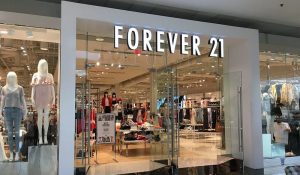On a cold November night in Georgetown, Ronnie sat against the wall of a closed store on Wisconsin Avenue. The temperature hovered around 38 degrees, but Ronnie didn’t have a coat, so he was wrapped in a comforter. He was wearing a pair of navy slacks, a dark blue hoodie with the word NAVY in yellow lettering across the chest, and two beanies—one black and sparkly, one green and knitted. When you are homeless, Ronnie said, fashion is not your most pressing concern, but this outfit was a stroke of good luck. It fit well and kept him decently warm on a cold night.
“You wear what you can find,” he said. “Sometimes you find it just right.”
Ronnie is one of thousands of people in the D.C. area experiencing homelessness. According to the annual Point in Time Count conducted by the Community Partnership for the Prevention of Homelessness, there were 6,521 people facing homelessness in the District on January 23, 2019. 1,606 of them were children.
For low-income people in D.C., choosing clothing might not involve much of a choice at all. They must dress for survival and success, often sacrificing the clothes they might like to wear for the ones they need.
In Georgetown, a slew of middle- and high-end clothing stores line M Street and Wisconsin Avenue. A few blocks from where Ronnie was seated, there is a Ralph Lauren store that sells the designer’s popular, upscale clothing. A few shops over, Vineyard Vines hawks $98 pullovers, and around the corner, an Urban Outfitters offers vinyl records and trendy clothes. For Ronnie, a store stocked with plush sweaters he can’t afford is useless. Most of the money he gathers on the street goes toward his next meal.
Ronnie was born in Chinatown and has been homeless on and off since 1974. In total, he estimates that he has spent 12 of those 45 years on the street. As the city has gentrified, Ronnie has seen prices go up precipitously. Where he used to be able to buy breakfast for less than a dollar, he now must spend about $8 per day.
At 38 degrees that night, Ronnie couldn’t rely on D.C.’s hypothermia prevention programs because the District only announces a Hypothermia Alert when the temperature falls below 32 degrees. Legally, D.C. is required to provide shelter for everyone seeking it during Hypothermia Alerts and dispatches vans to shelters equipped with jackets, gloves, and blankets. This winter, the National Oceanic and Atmospheric Administration predicts above average precipitation, meaning the upcoming winter could be a difficult one for those without housing and warm clothing.
Ronnie has found creative ways to stave off the cold. He sits on the lid of a styrofoam cooler to protect himself from the concrete. Ultimately, though, he credits his endurance during the winter months to biology. “Your body is a marvel of adaptability. I can sit on the ground and not be cold. You’d be real cold, but your body’d adapt to it.”
The Father McKenna Center distributes apparel to men experiencing homelessness on the first and third Tuesdays of every month to alleviate the dangers of inclement weather. In the winter, they mostly offer pants, sweaters, jackets, gloves, hats, and scarves. Ned Hogan (COL ’74), director of development at the center, described what the center’s clients seek most often.
“They’re looking for something to stay warm, or in the heat of the summer something to help them stay as cool as possible,” Hogan said. “They’re looking for something that’s serviceable.”
Though most of the clothing the Father McKenna Center gives out is donated, Hogan said they sometimes have to purchase blue jeans, a much-needed item. He also pointed out that most, but not all, donations the center receives are helpful to its mission.
“We don’t need clothing with holes in it. I know it’s very fashionable for teenagers and college students to wear jeans with holes in the knees to make it look worn and so forth. That’s not what the guys need,” Hogan said. The center also opts to purchase underwear instead of taking donations. “You wouldn’t wear your sister’s underwear, these guys shouldn’t have to wear somebody else’s.”
Not all locations that distribute donated clothing are equal in Ronnie’s eyes. He says he prefers to find his clothes from locations other than shelters because he doesn’t know where the clothes they distribute have come from. “Something about shelter clothes I don’t like. I don’t trust them,” he said. “I’ll wear them, but I don’t trust them. I don’t know, there could be something wrong with those clothes.”
Anna Stone (COL ’15) is well acquainted with the complicated politics of donations. While at Georgetown, she coordinated service projects with various nonprofits in D.C. Now she resides in Bozeman, Montana, where she works as a housing counselor for the Human Resource Development Council (HRDC). Stone says well-intended donors often fail to consider how useful their gifts are to the community they want to serve, and that organizations must walk a careful line when it comes to guidelines on donations.
“We have a Keurig in our office, and we just use the Keurig cups from the food bank. If you don’t have a kitchen, you don’t have a Keurig,” Stone said. “Talking about specific donations is hard because it can come across as ungrateful. Like, ‘oh, I like that, but I won’t accept this donation.’ People don’t want to hurt that relationship. Any sort of specifics or being seen as being choosey is a dangerous prospect.”
Like Hogan, Stone sees gaps in some of the donations HRDC receives. Unlike the center, they serve men, women, and families. Stone said she often doesn’t know what to tell parents looking for children’s clothing. Most donors are adults and focus on sharing their own used items.
Beyond clothing for families, Stone said her organization needs more donations of professional clothing. At a job interview, a candidate’s clothes can sully an employer’s first impression. Job seekers—often told to “dress for the job you want, not the one you have”—can struggle to find professional clothes if they are homeless or low-income.
A 2018 Business Insider article advised readers to spend about 5 percent of their after-tax income on professional clothing. According to the article, a high-quality business suit can cost up to $1,000, but if you’re looking to save, you might be able to find one for $250 to $300. For those without enough income to cover basic necessities, this cost can be insurmountable. In Bozeman, Stone said, there’s a housing crisis caused by high housing costs and low wages, which means working people often can’t afford stable housing. In fact, many of HRDC’s clients are employed—something donors often don’t realize.
“If the people who are donating the clothing don’t have a conception of people that are working, they’re not going to be donating their old suits or anything because that might seem silly to them,” Stone said. HRDC offers thrift store vouchers to clients to supplement donations so they can select their own clothes, including work attire.
D.C. itself is also in the midst of an affordable housing crisis. According to a September 2019 study by the Urban Institute, D.C.’s housing stock is 264,000 low-cost units short of residents’ needs. If economic growth in the District continues at its current pace, the area will need 374,000 more low-cost housing units by 2030. Throughout his life in D.C., Ronnie has seen D.C. affordable housing efforts stall and is skeptical the government will act any differently now.
“They let a brand-new, nice building be built in a black neighborhood in Southeast or Northwest. They open the building up and rich white people live there,” he said. D.C. law requires new developments of ten or more units to hold a set amount of square footage aside for affordable housing, but even that is often not enough. “The price of housing is too high for poor people.”
Ronnie believes black people bear the brunt of D.C.’s homelessness problem. According to a 2017 article in Street Sense, a newspaper that reports on homelessness, 71 percent of D.C.’s homeless population is black. Ronnie doesn’t think this is a coincidence. “That housing stuff boils down to your race,” he said. “It ain’t just affordable housing, it’s a race issue. It ain’t about building a house, it’s a race issue.”
Even if someone has a job in the District, the cost of housing has outrun many workers’ wages and leaves little room in their budgets for professional attire. Founded in 1992 with the goal of providing mentorship and professional clothing to women in need, Suited for Change tries to help fill in the gaps. Sena Tsikata, the group’s communications and development director, said though the women they serve vary in everything from profession to education—some of their clients only have high school diplomas, while others have master’s degrees—many of them are mothers. Tsikata said about 69 percent of their clients are the primary breadwinners for their families and often feel pressured to choose between necessities like diapers and groceries and their own clothing needs.
“What we are doing is helping them not have to make that decision, helping them see that they can focus on their families and still focus on themselves without having to lose out,” she said. “Being able to have free professional clothing is so important in that area because they’re able to make decisions without any form of guilt, any form of anxiety, any form of worry.”
When women have completed job readiness programs with partner organizations, they can get a referral to Suited for Change, which will pair them with a trained volunteer who can help them select business attire and accessories for interviews. After a woman has been offered a job, she can come back to Suited for Change and pick out a week’s professional wardrobe so she can look her best at work.
“The clothes that we wear have a huge impact on us because we’re either going to walk into a place feeling confident or not based on what we perceive ourselves to look like,” Tsikata said. “Once that outfit is placed on them, they can actually now see it happening.”
Tsikata said Suited for Change aims to serve as many women as possible. They make sure to carry clothes for women size 14 and above, unlike, they say, many other nonprofits doing similar work. Most of the clothing they distribute is donated through partner organizations and women’s groups, but if the boutique is low on plus sizes, they partner with a local store to purchase appropriate sizes at discounts to give to their clients.
“We have such a diverse group of incredible women that we serve here,” Tsikata said. “We reflect the everyday woman.”
But these logistical concerns are not the only difficulties for those who struggle to find clothing. Hogan believes there is an immediate stigma passersby associate with homelessness.
“One of the struggles that we always see is the way that somebody treats the homeless on the street when they look homeless, and you often watch people avert their eyes and cross the street to get away from somebody,” Hogan said. “We treat them as if they’re invisible. We don’t give them the respect that they deserve for being a human being.”
To Stone, who believes the first step to assisting people experiencing homelessness is stopping and having a conversation with them, the perception of homelessness can limit the help given to those in need. And for those experiencing homelessness, the struggle to find clothes can limit how they express their identity. For many people, a t-shirt might reflect a favorite color, musical group, or team. When a person relies on donated or thrifted clothing to make ends meet, they lose agency over these decisions, and their clothing becomes depersonalized. “It’s the experience of homelessness being isolating and really making people feel powerless,” Stone said. “The little pieces of identity that can come from clothing are sort of distorted.”
On that chilly night on Wisconsin Avenue, Ronnie was less concerned with questions of identity and self-confidence and more focused on the winter ahead. Asked what he would wear if he could choose any outfit, he was all about practicality. “A pair of thick pants, thick pants. A thick shirt, a sweatshirt. Something thick and heavy.”





